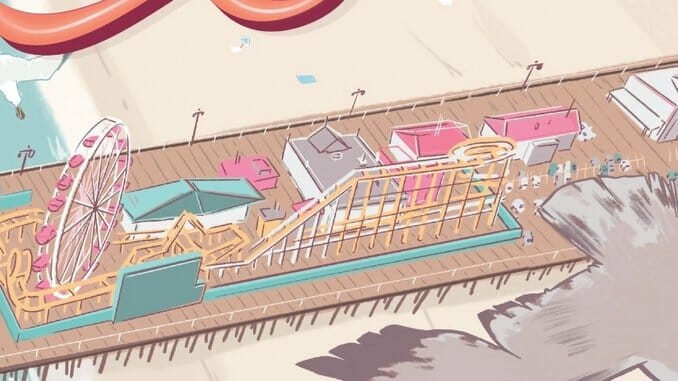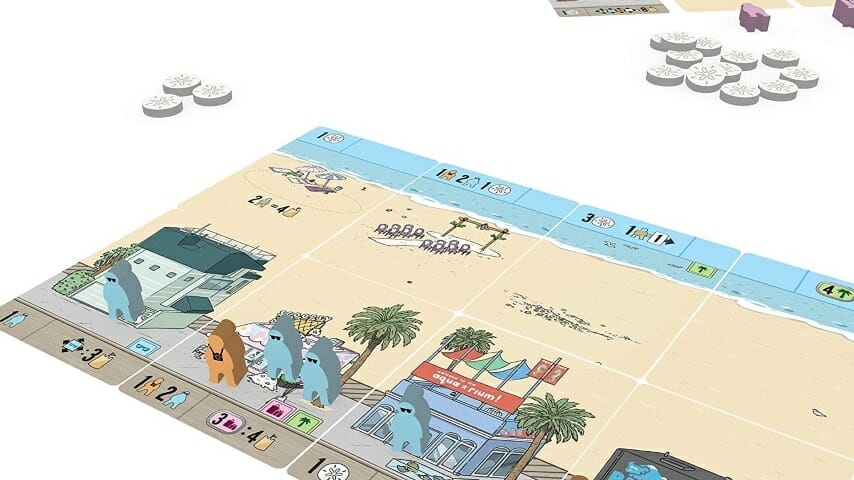
Santa Monica has a great premise at its core. It asks players to build their Santa Monica boardwalks with cards they take from the market, gaining meeples to place on those cards and to try to move to cards with ‘activity rings’ to score points. It’s too bad that moving those meeples is so difficult, because it means the thing that makes this game clever is too often missing from the gameplay.
The deck in Santa Monica comprises beach cards and street cards; you start with a Starting Feature Card that is the height of two regular cards, and create two rows, with beach cards on top and street cards on bottom, extending in either direction. These cards can grant you extra meeples—blue locals, orange tourists, green VIPs, and purple horseshoes (okay, I made the last one up)—or sand dollars, which function as a sort of currency in the game. The cards can also have one or more location tags, or activity rings where you’ll place meeples for points, or can give you points based on what tags are on adjacent cards or if the card itself is part of a chain of similar cards. There are a lot of ways to score, but they all relate to card or meeple placement, and it all makes sense in the game’s overall theme.
Nothing in the game has an actual cost unless you choose to use sand dollars for one of the game’s two special actions. You take cards for free from the bottom row of the 2×4 market of cards—the top row is there so you can see what card will drop down to replace the chosen card on the bottom—and then may gain things for free from that card. You can skip that action, however, and spend sand dollars to do something more powerful, like taking a back row card and moving up to four meeples on your boardwalk one space each, or taking two cards from the front row in one turn and moving one meeple one space.

The meeples’ placements matter in two ways for the final scoring. If you can get the right colors and numbers of meeples into activity rings, you can score, usually two to five points. However, if you end the game with meeples outside of those rings, you can lose points, such as one point per card with unplaced meeples. You also start the game with one green VIP meeple that can get you points simply by moving around the cards. Whenever your VIP passes through a card with either of the two location tags shown on your starting feature card, you place a footprint token on that card, scoring you one point per token at the end of the game.
The fundamental flaw in Santa Monica is that you have far too few opportunities to move meeples, and moving them any great distance along your boardwalk is almost impossible. Out of the 78 cards in the deck, only 12 of them give you the power to move meeples—one of which only lets you move meeples on to that specific card. You have to use sand dollars to trigger those special abilities to move meeples—and some sand dollar tiles don’t have that full power—or select the card above the Foodie token in the market, which lets you move one meeple one space for free. (The Foodie and the Food Truck, which gives you one free sand dollar, move one space to the right every time their powers are invoked.) At game-end, you get to move all of your tourist and VIP meeples one space each, and all of your local meeples up to three spaces each, but the cognitive load of remembering that option and setting up your board to make use of it is out of proportion to the rest of the game. The deck should have far more cards with this ability on them, or there should be an easier method to let you move meeples—such as paying one or two sand dollars for free moves.
The art and theme in Santa Monica are both very appealing, with bright pastel colors throughout the game and a theme that’s well-integrated into how it plays. Many cards have artwork that lines up with the card’s tag(s) and abilities—the beach volleyball card has a sports tag, lets you score if the card is part of a chain of cards with at least three total sports tags, and has an activity ring that scores two points if you get two meeples in it. (Beach volleyball isn’t much of a solo activity.) The card that has nothing on it but a sign warning you that there are sharks in the water and a fin in the ocean gives you four sand dollars, but deducts four points if any card adjacent to this has a power that grants you meeples. The Camo Lodge (say it out loud) lets you move up to eight tourist meeples one spot each, which is powerful but also probably not very useful given how hard it would be to get that many meeples of that type in any single game. I can see how much thought went into this game, including these details that don’t really matter for gameplay but make games a bit more enjoyable when they’re done right. It’s unfortunate that the game’s mechanics didn’t get that same kind of meticulous attention, making the most interesting part of the rules the hardest thing for players to do.
Keith Law is the author of The Inside Game and Smart Baseball and a senior baseball writer for The Athletic. You can find his personal blog the dish, covering games, literature, and more, at meadowparty.com/blog.